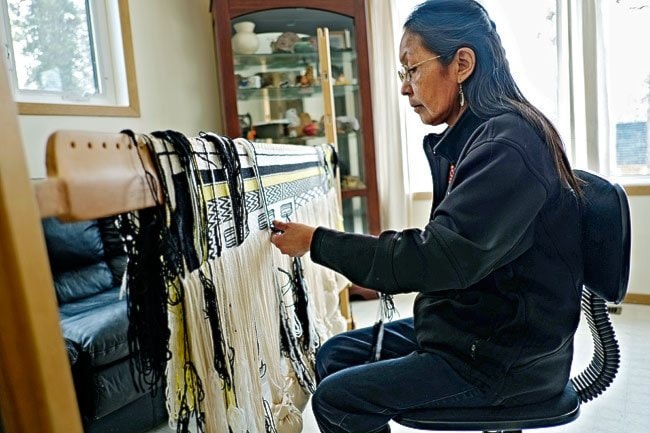Ann Smith’s fingers flick nimbly as she weaves coloured wool onto the warp, meticulously building a design across the fabric. She is seated at her loom, her back bowed to her work and bathed in soft morning light from a large window. Behind her sits a darkened TV and a stack of her grandchildren’s X-Box games.
Smith is an expert traditional weaver. Her specialty is the Ravenstail style, an ancient custom that has lived on Canada’s Northwest Coast for generations.
Her work is in art collections across the country. A three-piece collection of a robe, leggings and an apron is displayed at the Aboriginal Affairs and Northern Development office in Ottawa. The robe alone is valued at $18,000. She has travelled across the world, from New York to New Zealand, teaching her craft and learning from others.
In June, she will help run a weavers’ gathering and workshop at the Kwanlin Dun Cultural Centre, as part of the Adaka Cultural Festival.
“The elders said one thing about this traditional knowledge is that you don’t realize how valuable it is. Your job is not to hang onto it. Our job as teachers is to pass it down to the next generation. That’s a weaver’s responsibility,” she said.
Smith will be met by her long-time friend and fellow weaver, Clarissa Rizel, and 10 other artists who specialize in Chilkat weaving, a more modern interpretation of Ravenstail.
“Our goal is to have the robes danced at the festival as well,” said Jennifer Allen, one of the festival organizers.
The weaving event will see traditional weavers from across the territory join guests from Alaska for a weavers’ gathering and workshop of around 20 women.
“The weavers’ gathering and workshop are somewhat separate events, but they’ll be happening in the same space, so visually it will be quite wonderful to see that many women sitting together weaving in an artist’s studio,” Allen said.
It will be the first time in years that Smith has been part of such a large gathering, and she’s excited about the chance to help grow the art form.
She needs to get young people interested in the art, she said. If they don’t start picking it up, it could be relegated to the history books.
But Smith isn’t alone in working to preserve traditions like Ravenstail. Her son, Sean Smith, is a dancer and together the two have presented her art to people across the world.
Sean was one of the traditional dancers selected to perform at the Vancouver Olympics. He wore his mother’s robe, the one from the Ottawa collection, for the performance.
“It was almost like everything came full circle for me. I was able to put that on my son, and he danced it for me with all my blessings,” Ann said.
“Sean did awesome. He danced amazing and he really enjoyed it,” Ann said. “When people saw them dancing, and they were coming out of the theatre in tears. They’d never seen such a thing, especially in the public’s eye. These robes are usually danced in ceremonies in the First Nations communities. Our people were so proud of these garments that they only wore them during special occasions.”
Idle No More has also revived a lot of interest in First Nations culture and traditions, Ann said. Since the movement began last fall, she said there have been many youth and school groups asking about getting involved with traditional dancing, weaving and other art forms.
“Everyone is all together. They wanted to join forces, mainly because we can support each other through the singing and dancing and weaving. We do that for each other,” she said.
Ann has been weaving since 1990, when she took a class in Whitehorse and fell in love with the art form. Her pieces at the Aboriginal Affairs office are the first she ever sold.
The craft requires nearly religious patience and self-discipline. It took Ann a year to complete the robe, leggings and apron that now reside in Ottawa.
She likes to weave in the mornings, when her mind is clear and the light is nice.
‘There’s only a limited time that you can do it because you have to look after yourself as well. If your arms or fingers start to ache, you take a break, you look after yourself,” she said.
Historically, Ravenstail weaving used mountain goat wool, which Ann said is some of the softest in the world. But in recent years many artists have switched to merino wool because of concern for mountain goat populations. It’s not quite as soft on the hands, and it is very precise work.
“The teachings tell us to strive for perfection, but that nothing is ever perfect,” Ann said.
The Adaka festival runs June 22 to 27 at the Kwanlin Dun Cultural Centre.
Contact Jesse Winter at
jessew@yukon-news.com
